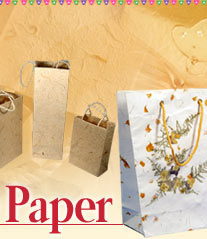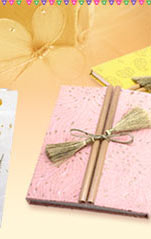|
|
The process of making handmade paper involves a series of steps that are briefly discussed below.
Sorting and dusting: the raw material that is to be used is manually sorted and foreign material like buttons; plastic, synthetic fibres etc. are removed. To remove dust and dirt the material is shaken vigorously.
Rag Chopping: The sorted and dusted material is chopped into pieces of equal size.
Beating: The raw material is mixed with water and harmless chemicals and beaten in a Hollander beater. This consists of a U-shaped trough, with a drum; on the outer side of this drum are iron blades that cut the raw material to make a pulp out of it. There is a washing drum as well that cleans the pulp and drains the dirty water. The quality of the paper to be made determines the consistency of the pulp.
Sheets of handmade paper can be made in two ways.
Dipping Method: This method is normally used for fine or thin paper. The pulp is diluted with water and put into a masonary trough or vat. The lifting mould (a mesh on a wooden frame) is dipped into the trough, shaken evenly and lifted out with the pulp on it. The consistency of the pulp in the tank should be kept constant all the time.
Lifting Method: This method is used for all paper and especially for card paper. A fixed quantity of pulp is poured evenly onto a mould, which is then clamped between two wooden deckles (frames) and then dipped into a water tank. The mould in then lifted using a lever mechanism that allows the excess water to drain away.
Couching: Once the sheet is formed, the wet paper is transferred onto a cloth like muslin or felt sheet and a stack of interleaved sheets in made.
Pressing: A hydraulic press is used to remove the excess water from the sheets. Pressing reduces the thickness of the paper and the sheets become more compact. This process improves the physical properties of the paper and helps drying.
Drying: Even after the sheets have been pressed, they still contain about 50% to 65% of the moisture. The sheets are hung in the sunlight to dry. Solar dries can speed up the process and the space required for drying. Coloured papers are dried in the shade to prevent the sun from bleaching the colour.
Cleaning and Sizing: Small particles of dirt and other foreign matter are removed manually with a sharp instrument. The cleaned sheets are coated with a layer of starch to improve the quality of the paper and prevent feathering. This process is called sizing. This can be done manually using a brush or by dipping the sheet into a vat containing sizing chemicals.
Calendering: The sheets are then placed between metallic plates and passed through spring-loaded rollers in a calendaring machine. This makes the paper smooth and increases the gloss of the paper.
Cutting: The sheets are cut neatly according the required size using a cutting machine.




